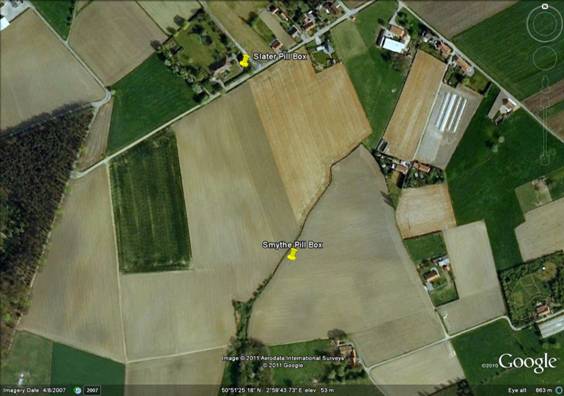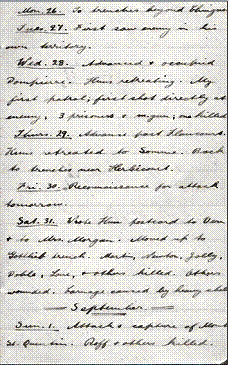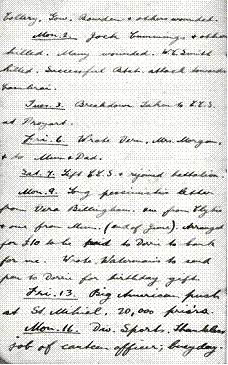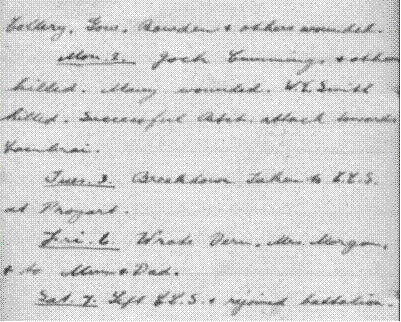Chapter 9 part 1:
Stories from the Front
I have tried whilst entering data to all my pages to use the word 'believe' when I had insufficient written evidence or enough valid anecdotal material. I have found this to be a good policy. Many times, after exhaustive research, my son and I have found that what family members heard/ remembered /understood/ believed was not always strictly correct. This also applies to writings in Battalion Histories, diaries and books.
Some of Vern’s stories were sent to me by Clyde Smythe (Viv’s son) and I have his permission to enter them here. I have also recorded some stories (and in other chapters) from my cousin Dorothy Bremner’s book on the Smythe Family History.
Vern was a signaller at the landing and was ordered with his mate to run a field telephone line inland from the beach head across the gullies and through the bush to the proposed future possible front line (or until they ran out of phone cable). They pushed through the bush unwinding the reel of cable, nervously looking out for Turks.
When the cable ran out it was daylight. They had expected the infantry to follow close behind them but there was no sign or sound of them after waiting an hour or more. They were already feeling isolated and vulnerable when they heard rifle and machine gun fire in the bush behind them and realized with shock that they were behind the Turkish positions and in danger of death or capture. They cautiously retreated through the bush back to the beach head without seeing a Turk, but exhausted by the stress of their actions. Never again did they advance as far inland as they did in the dawn light on the morning of the landing.
Vern said on the first day in Gallipoli was the most stressful and tiring. They started the day at 2am on the troopship and kept going until 10pm when he settled into a ”funk hole” he had scraped in the lee of the overhanging ridge up from the beach. Every time he dozed off he would have a nightmare of a Turk creeping through the bush and bayoneting him as he slept.
***
A few days later Vern’s officer, Goldberg was hit in the throat and taken out of the trenches with no one available to replace him. Vern aged 20 took over in the emergency. General Hamilton mentioned him in despatches and he was promoted in spite of his youth. He was described as “short in stature, trim of build and dapper in appearance. His face had the frank expression of a healthy schoolboy.” He liked to carry a baton and always looked tidy. He was well-liked and known as a very witty person.
***
Percy had met his brothers in dug-outs in Shrapnel Gully (Gallipoli) and thought Bert looked unkempt and Vern a bit haggard. As they didn't smoke, they gave their cigarette allowance to friends from Sydney. Bert was used as a sniper because of his marksmanship.
***
While in Egypt, Viv was in charge of Guards escorting A.I.F. prisoners on a train to the docks in Egypt, to be sent back to Australia for dishonourable discharge. His comment was “They would murder their own mother for six pence.” as a description of their character. I have been told that many of these men changed their names, re-enlisted and returned overseas.
***
Clyde was told, when he met some men from the 56th Btn. at a dinner that they all considered Vern as a very brave man. The action at Fromelles, where Vern was awarded his first Military Cross was repeated to us a few times. At that action, some soldiers were trapped in the 1st German Trench and Vern asked for volunteers to dig a trench towards the men, so they could try to escape that way. Evidently, he was new to the company and they just sat and looked at him and thinking something like this we were told “Who is this upstart of a young officer – who does he think he is?” Vern climbed on top of the trench and walked along for a short while. He knew the way the Maxim machine guns worked and how long it took to reload (from his time at Gallipoli) and knew how many seconds it would be before the bullets could hit him and he could then jump back down. The men all volunteered but sadly some of them and those they tried to save died in the attempt. Vern would never go back to the battlefields, as he said he lost too many young men there.
Further stories about this are below and these vary slightly but the facts are much the same. You must remember these are from remembered conversations and time does dim the details sometimes.
Fromelles, France. German reoccupy their second line trench. Australian dead and wounded remain. After three days of rain, at 6am on 19 July 1916, the 5th division AIF attacked the German trenches across the boggy No Mans’ Land under heavy German artillery bombardment to capture the 1st and 2nd enemy trench lines. Massed machine gun fire from the 3rd line caused crippling casualties among the Australians and over 1,000 became trapped in the 2nd German Line. At 1am, Captain V.E. Smythe organized volunteers from his 56th Bat. Reserve to dig an escape trench across No Mans’ Land linking hollows and shell holes to the German lines allowing most trapped Australians to get back to their own trenches. Captain V.E. Smythe was awarded the Military Cross for his actions.
Captain V.E. Smythe was a Gallipoli veteran newly promoted as Company commander in the new 56th Btn. AIF in France. His Company consisted of Gallipoli veterans and many new reinforcements who had no confidence in him. Fromelles was their first major action on the Western Front. When he called for volunteers to dig across No Man's Land under withering machine gunfire, to attempt the rescue the response was negative. He then climbed out of the trench and stood on the parapet saying he would not ask anyone to do anything that he would not do himself. As a machine gun traversed towards him, he walked along the parapet and jumped down into the next bay of the trench. He confided in Clyde that he knew from Gallipoli experience that German Maxim machine guns traversed slowly to avoid jamming the belt. He estimated he had 5 seconds before he was in the line of fire.
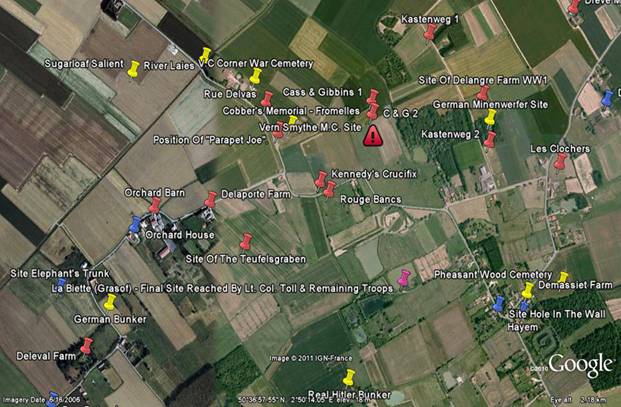 Approx. position where Vern was awarded his first M.C. at Fromelles
Approx. position where Vern was awarded his first M.C. at FromellesFrom Perce's diary, Thurs. 2 November 1916. He wrote of Vern's description of the Battle at Fromelles. There is nothing about Vern's actions there that led to his first Military Cross.
“Viv learned that the 56th. were camped not far away, and we went over and found them in a tent encampment. Vern was there, all O.K., though well bespattered with mud. First time I've seen him since leaving Tel-el-Kebir eight months ago. He gave us a description of the Armentieres stunt. It appears it was all a diversion to draw attention away from the Somme, and was widely advertised for the benefit of German spies by bringing up big howitzers etc. through Sailly and Fleurbaix in broad daylight. There were two divisions to go over, our 5th. and a Tommy division. Half an hour before the zero time the Tommy divisional commander refused to take his division into the stunt, so our fifth division went over alone, Vern's brigade in the centre, and his battalion in reserve. They got three lines of trenches, but the brigade on their right failed completely and were cut up, and that on their left, being composed mostly of new men, began to fall back when they were a little pressed. That left them exposed on both flanks, and they were gradually forced back. The flooding incident occurred when they had retired to the German front line, and was only of minor importance. Hun prisoners told them that there were strong German forces held in reserve for a counter attack, so that in any case they would probably have had to retire.”
***
Viv's son Clyde, advised that Pozieres was Viv’s worst experience of the war with Bullecourt and Passchendaele close behind. Clyde also wrote on another report that Viv described Pozieres and Mouquet Farm as 'his worst of the worst trials in W.W.1.' He particularly felt that being 'packed tight in "K" Trench (Pozieres) in total darkness - ordered not to move - while being shelled by an intense German barrage was virtually beyond endurance. The successful attack on the Hindenburg Line at Bullecourt was regarded by his father as his most satisfying action of the war. This battle was know as 'The Blood Tub'.
He had not been at Gallipoli but those who had, said that in this single battle, divisions were subjected to greater stress than the whole of the Gallipoli campaign, with greater loss of life.
***
Between 9 July and 10 September 1916, Bert was at Sigs School in England teaching signalling. He was regarded as an expert in semaphore and got 299.5 out of 300 in signalling, beating everyone including the officers. He had attended a special course in instructing and became part of the First Training Battalion.
***
August 1916. When Viv was ordered to attack Mouquet Farm with some of his company, he found it hard to find enough able bodied soldiers to carry it out. He knew if it went ahead they would all be killed, so he told the men to write their letters home. After the dreadful number of casualties/deaths that occurred at Pozieres, it was decided when possible to give this instruction.
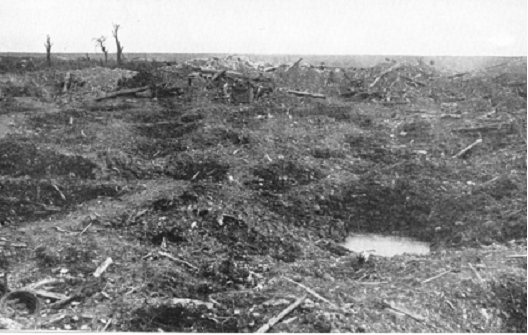 Mouquet Farm - Pozieres about one mile beyond the crest
Mouquet Farm - Pozieres about one mile beyond the crestIt was during the battle at Mouquet Farm that Viv obtained a Prussian Guard helmet that he was able to bring home.
***
29 December 1916. Perce wrote in his diary about one man being reported to him as being murdered by two others in his tent. (7 October 1916) I checked these men’s documents and they both returned to Australia and I could see no mention of any Courts’ Martial. One was in lots of trouble over his service life for being AWL and lots of other misdemeanours. The “allegedly” murdered man’s documents had nothing about enquiries except a note on a yellowish piece of paper “Court of Inquiry re Death In Safe”. His father received word from some of his son’s mates about the murder but there is nothing about any replies to his enquiries to the army about his son’s death is in the Service Documents. I have not found any documents in the National Archives about the inquiry. Perhaps they are still secret. Enquiries at the Australian War Memorial did not bring and any further information..
***
9 March 1917. (Date on Army Form W 3121) Viv’s first Military Cross is shown in the records as happening at Warlencourt near Dinkum Spur, as well as the area around the junction of Malt and Gamp Trenches, and Emmy Alley, approximately 250 metres south of Loupart Wood. The date of the action is shown as 26th February, 1917. This is considered to be part of the overall Battle of the Butte de Warlencourt, which is approximately 1.5 kilometres in a South Easterly direction away from the Butte.
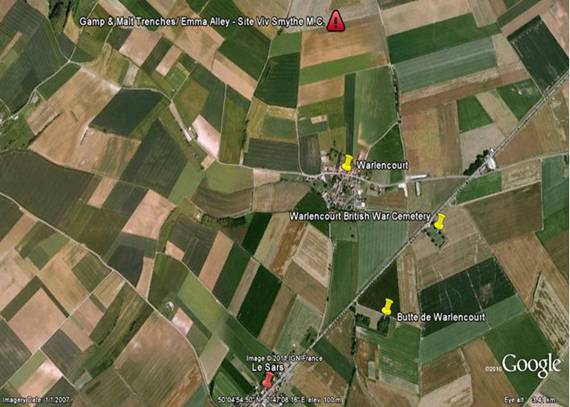 Approx. site where Viv was awarded his first Military Cross -- Malt and Gamp Trenches and Emmy Alley.
Approx. site where Viv was awarded his first Military Cross -- Malt and Gamp Trenches and Emmy Alley.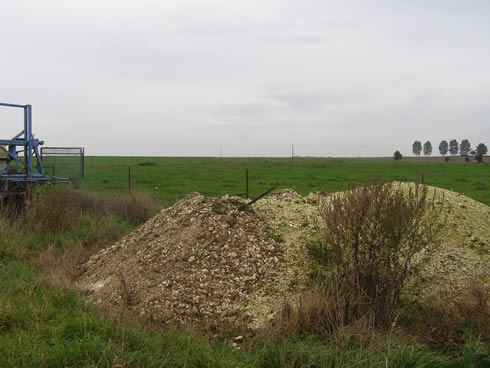 The position mentioned above would be just below the skyline on the left near the oblong part of the machinery.
The position mentioned above would be just below the skyline on the left near the oblong part of the machinery.
Photo taken October 2010 When we visited the Butte in 2007, we had no idea that Vern Smythe was also in the Warlencourt area for a few weeks early 1917. Viv’s citation mentioned Warlencourt and that is why we went to that location. In 2008, we learnt from some newly discovered notes written by Vern in 1976 (see details Chapter 13) that he was initially situated some 200 metres south of the Butte de Warlencourt. His company was later moved in a South Easterly direction from the Butte on the extreme right of the Corps to roughly half way between Guedecourt and Le Transloy to a very important lengthy trench running due south off Sunray Trench, called Finch Trench, which they helped to capture.
***
The Germans were withdrawing from the Somme to the Hindenburg line in March 1917, fighting a rearguard action as they went. It was very difficult to find where the Germans were as they often strongly defended some trenches but not others. One uncle, when fighting near --- was in the front line at dusk and saw a German trench about 500 yards away across ‘no mans’ land that appeared to be deserted. He called on other officers and sergeant to confirm that there was ‘no one there’. Several large shell craters were about 50 yards out in ‘no mans’ land’ and it was considered that the German trench raiders could occupy the craters during the night and make a surprise attack on their front line trench. To forestall the Germans, this uncle ordered a platoon of 35 men armed with Lewis guns and grenades to occupy the craters. The 35 men lined up in their trench, there was a blast of his whistle and they scrambled over the top and charged towards the craters. No one got there! Five German machine guns killed every one of the 35 men. Uncle was so distraught at witnessing this horrible event, he tried to climb out of the trench to die with his men but his C.O. ordered him back. This incident haunted him all his life and he was visibly upset when talking about this in 1967.
***
The family knew Vern had been wounded on 2/4/17 by a G.S.W. to the right leg from details in his Service Documents. Because of this, Vern was not with the 56th Battalion at the 2nd Battle of Bullecourt. I was informed by a historian at A.W.M. that this occurred near Louverval. Perce wrote about the incident in his diary some days later after visiting Vern in Wandsworth Hospital. The spelling Perce used for Doigines is not correct and should be Doignies.
9 April, 1917. Perce's diary: Verne looked well and cheerful. He had got a small piece of H.E. in the right leg below the knee. It did not seem to bother him much, but he could not walk. He was wounded in the attack on Doigines, when the 55th. & 56th. attacked, the former losing only 11 officers & the latter only 10. Mr. Wilson, late of our old 7th. rfcts. of the 3rd. Bn., now of the 55th., was in a bed just opposite, having been wndd. in same battle, by a bullet thro the leg. It is more serious than Verne's, as the bullet grazed the bone.
***
May 1917. Viv told his son that his closest shave was at Bullecourt. The Australians were fighting for control of the German trenches when an enemy bombing party came storming along the zig-zag trench throwing grenades in front of them. A stick grenade landed on the trench top right next to his head. The blast threw him against the trench wall. He thought he had been mortally wounded and felt his head and face and found no injuries. He could hear nothing but a screaming ringing in his ears. The battle raged on and after a few minutes later he was back in action. He explained that the grenade was a ‘dud’. No mention was made of this incident in his letter home to his parents about Bullecourt, where his brother Bert was killed.
***
From Perce's diary Mon 25th June 1917 "While enquiring at one of the orderly rooms, I had met a 24th B'n man who knew Viv, C.S.M. Garrick, and he told me how Viv got the Military Cross. It appears that during the great retreat of the Huns last March Viv took out a patrol in daylight to try and locate the enemy, who had fallen back some miles. When they found them they hopped into a Hun trench, and the occupants fled. They then held the trench all day against the enemy, until a company of our boys came up at night and took over from them."
***
5 October 1917. As Vern’s Bar to his Military Cross (M.C.) was shown as happening at Polygon Wood, the family believed that the action actually took place within the Wood. When my son and I visited there in 2007 (I did not join them on this walk.) My son and companions went in the opposite direction to the way the troops had moved) and he photographed a pillbox that he thought might have been the one that had captured based on a small amount of information then available.
However, my son was later informed by an authoritative historian at the A.W.M. that the action which gave rise to Vern being awarded a bar to his M.C. occurred after Vern and some of his men left the Polygon Wood to attack some German pillboxes, which were severely impeding the Brigades moving forward after the successful attack on the Wood. These two pillboxes were about 100 or so metres due east of the Butte at Polygon Wood but our research has revealed that these 2 pillboxes no longer exist, having been destroyed by the local farmers wishing their farmland returned to them.
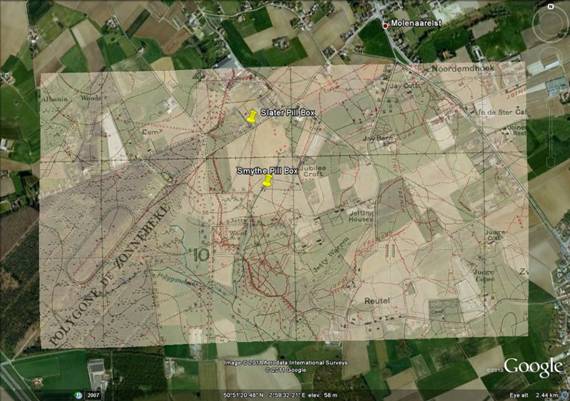 Battle Map overlaid on Google – Vern’s Pill Box position is indicated by lowest marking.
Battle Map overlaid on Google – Vern’s Pill Box position is indicated by lowest marking.
(Prepared by Peter Benson - Member FFFAIF)
Lieut. Colonel Scott, who was the 56th Battalion commanding officer (killed 1/10/17) originally recommended Vern to receive the Distinguished Service Order (D.S.O.), however the powers that be later deemed that he be awarded a Bar to the existing M.C. There is the supposition that had Lieut. Colonel Scott not been killed in action a short time later, the D.S.O. would have been awarded, as he would have been able to justify his request for that award.
The Brigades then advanced towards Dairy Wood near Broodseinde Ridge.
A friend of the Vern Smythe, George Norman Dixon (brother of Ralph) wrote to his wife Jesse on 21/10/17. In this extract he mentions Vern’s actions at Polygon Wood.
--Vernie (Smythe) came through last stunt OK and with as much bravery as usual, he's got some pluck right enough, and did some very good work. I wouldn't be surprised to hear of him getting his majority (promoted to Major) and probably another distinction (medal), nearly all his seniors were 'put out' (all his senior officers became casualties) recently. --
***
Viv was the only Senior Officer of the 24th Battalion left in the line at the end of the Battle Broodeseinde Ridge on 9 October, 1917 and was awarded a Bar to the Military Cross for his actions.
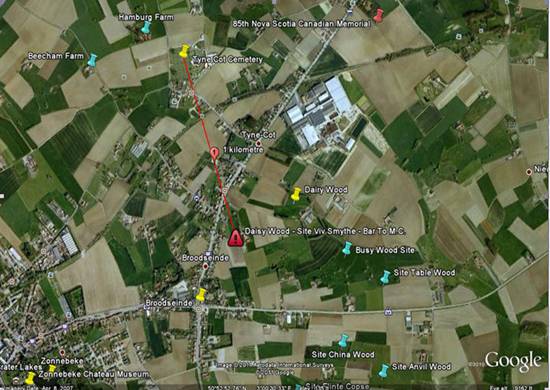
The approx. position where Viv was awarded his 2nd Military Cross about 1 km from where
Tyne Cot Military Cemetery now stands. See Chapter 11 for full details.
Vern was in action at Dairy Wood sited towards North East on this map.***
11 Nov 1917. Percy wrote in his diary ... they (Germans) plastered our front line with gas shells, most of them, however falling higher up than our positions. The pungent reek of gas floated down our way, but we gave it little heed. Then they gave us some high explosive shells for a change and some of them came uncomfortably close. Once the sighing whine of a shell in flight ended with a savage hiss and an explosion just behind our dugout, and I felt the sandbag wall heave in several inches. “That one nearly smashed our dugout,” I remarked, thinking it was an H.E., but the next moment a strong smell of gas rushed in. “Get your respirator on.” I yelled at Gus, making a grab for my own. I held my breath but the powerful fumes got into my eyes, and the tears poured from them in streams. The tapes of my respirator were twisted up with the mouthpiece somehow, and there I was struggling to get them free. Had to open my eyes several times and endure a fresh flow of tears, and it soon became impossible to hold my breath any longer. However, just as I got a good deep breath of poisonous gas, the mouthpiece came free of the tapes and I got it into my mouth. It was easy enough to adjust the rest of it. We stood to with respirators on for about half an hour, and when the “all clear” message was sent along, I looked at the corner of the dugout, just two feet from where my head rested against the sandbags! Had it been an explosive shell of even the smallest calibre, this record would have never been written.
***
Percy had completed his officer training some time before the Battle of Mont St. Quentin. This interesting Confidential Report was found among his Service Documents. It was compiled on 4 May 1918, when he was a Cadet Officer at Cambridge. He may have been pleased, if he had known the contents. It showed "Scientifically Inclined. A useful type."
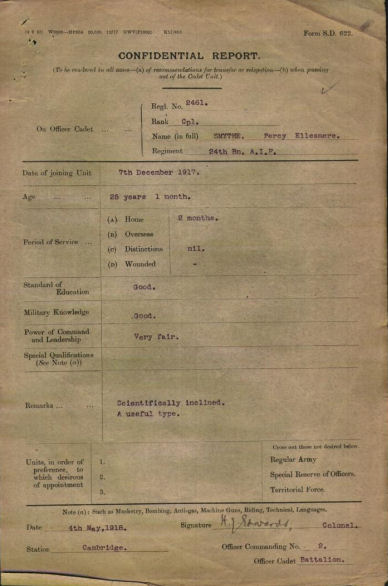
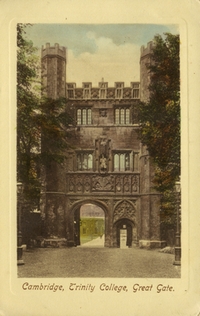
Perce wrote in his diary on 28 August 1918 of an incident at Mt. St. Quentin when either he or his companion wounded one of two soldiers. This German appeared not to be badly hit but was prostrate on the top of the trench and trying to put up his hands. A rifle barrel appeared over Perce's shoulder and though he called out not to shoot, his companion killed this helpless, unarmed enemy soldier. Perce was very upset but understood that some men's anger at recently losing mates caused them to act irrationally at times. Perce stood in front of the 2nd soldier, so that he did not have the same fate. This happened during the battle and I do not know the outcome. Shooting of an unarmed soldier, who thought he was now safe, was not an isolated incident and sadly happened on both sides during the war.
On the 30th the colonel addressed a conference about some unsatisfactory performances but praised some individual initiative actions. He also said that "a very brilliant piece of work" was done in mopping up a Hun post in Attila trench. There was an entry on the 1st that could have covered the final sentence shown on the award, where he oversaw the withdrawal of his group to the shelter of the cemetery wall, so it is possible, as both were part of the Battle, they were put on the one recommendation and dated the 1st. from Perce’s diary 30th Aug 1918
The family originally considered that the capture of a German post and the taking three prisoners took place in Elsa Trench. However, Elsa trench was the jump off area for the final assault on the Mont and in the 24th Battalion History ‘The Red and White Diamond’, Page 72, details an entirely different story. The action appears to have occurred in a trench near Herbecourt (approx 6 km. South West of Peronne) called Attila Trench after Perce left Martinique Alley (near Attila Trench) and this corresponds with his short notes and the writing in his diary.
Entry in brief notes reads :-
Wed. 28 Advanced and occupied Dompierre. Huns retreating. My first patrol; first shot directly at enemy. 3 prisoners & m. gun; one killed.
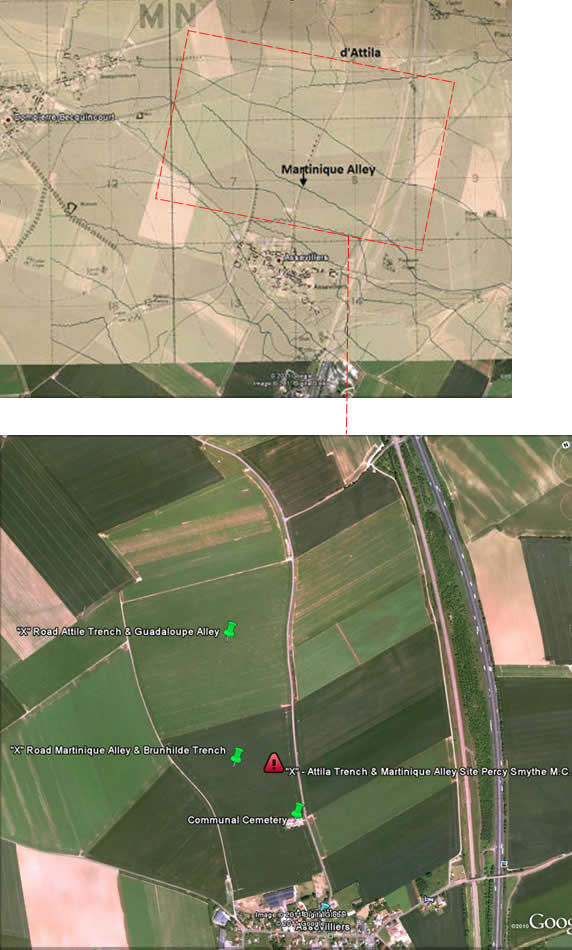 The overlay on the top map was prepared by Peter Benson, (a Member of FFFAIF) and the red marker is the approximate position of where Lieut. Percy Smythe was awarded his M.C. as described in his diary. Dompierre-Becquincourt is top left and the village of Assevilliers is in the centre.
The overlay on the top map was prepared by Peter Benson, (a Member of FFFAIF) and the red marker is the approximate position of where Lieut. Percy Smythe was awarded his M.C. as described in his diary. Dompierre-Becquincourt is top left and the village of Assevilliers is in the centre.
My son and I carried out some further research and now believe that he was awarded the M.C. for those actions taken on the 28th August, though the award stated that it was on the 1st September. His diary of 28th, details the action and the following record from his short notes (before entering them in the diary- see below) shows the same date. He and his men were congratulated later by other members of the battalion and the Major of his company. His diary on the whole battle is very long and descriptive and those in his notes very brief. I have no doubt from his records, that he was heavily involved in actions at Mont St. Quentin, until the 3rd September, when he became ill. It is also possible that the M.C. may have been awarded for multiple continuing examples of bravery and inspiring leadership. A 2nd Lieut. at Battalion H.Q. on the 2nd, said “Hello, Smythe! You really are one of the fighting Smythes all right.”
A contact in England, advised me that her grandfather Major Donald Coutts was with the 24th Bn. at Mont St. Quentin. She believes that her Grandfather would have been the Medical Officer who initially attended to my uncle Lt. Percy Smythe (see brief note in his small diary) when he became ill on the 3rd September 1918 and was evacuated to the Casualty Clearing Station.
Perce told his daughter Betty that the official wording of the granting of his Military Cross at Mt. St. Quentin (dated 1 September 1918) was not exactly as he remembered it.
***
In Uncle Percy’s diary, relating his experiences at Mont St. Quentin 1st – 3rd September 1918 (), he wrote of Lt. E.T. Towner M.C. - 2nd Machine Gun Battalion (attached to the 24th Battalion), who was later awarded the Victoria Cross for his actions on 1st September 1918 in that battle. Some of the words in Percy’s diary regarding Lt. Towner’s bravery on that day are similar to those published in the Gazettal of the award on 2/6/1919. (my Uncle may have been the officer or one of the officers interviewed with regard to the awarding of the Victoria Cross to Lt. Towner,)
“The Machine-Gun officer, Mr. Towner, put his company into the trench on our left. Besides his own guns, he also mounted a number of German guns, in order to make our line the more secure against counter-attack. These captured German machine guns were lying about everywhere. It is a lasting disgrace to the enemy that we were able to take the position when he had it so strongly fortified. Mr. Towner had been wounded in the head, but refused to go out of the line, saying there would be nobody to look after the guns if he went. He struck me as being extra-ordinarily cool and game. Nothing seemed to trouble him, and he worked tirelessly at getting his men and guns organised in the best possible positions, often incurring a lot of personal risk in doing so. His habitual calmness went a long way towards encouraging the men.”
His Majesty the KING has been graciously pleased to approve of the award of the Victoria Cross to the undermentioned Officer:- (copied from the letter sent home to his mother 2/6/1919)
Lt. Edgar Thomas Towner, M.C., 2nd Bn., Aus. M.G. Corps.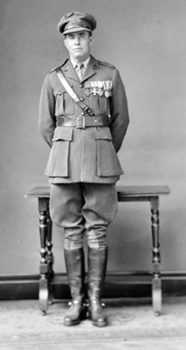
For most conspicuous bravery, initiative and devotion to duty on 1st September, 1918, in the attack on Mont St. Quentin, near Peronne, when in charge of four Vickers guns. During the early stages of the advance he located and captured, single-handed, an enemy machine-gun which was causing casualties, and by turning it on the enemy inflicted severe losses. Subsequently, by the skilful, tactical handling of his guns, he cut off and captured twenty-five of the enemy. Later, by fearless reconnaissance under heavy fire, and by the energy, foresight and promptitude with which he brought fire to bear on various enemy groups, he gave valuable support to the infantry advance. Again, when short of ammunition, he secured an enemy machine-gun, which he mounted and fired in full view of the enemy, causing the enemy to retire further, and enabling our infantry to advance. Under intense fire, although wounded, he maintained the fire of this gun at a very critical period. During the following night he steadied and gave valuable support to a small detached post, and by his coolness and cheerfulness inspirited the men in a great degree. Throughout the night he kept close watch by personal reconnaissance on the enemy movements, and was evacuated exhausted thirty hours after being wounded. The valour and resourcefulness of Lt. Towner undoubtedly saved a very critical situation, and contributed largely to the success of the attack.
* * *
The officer, who took over from Capt. later T/Major E V. Smythe in 1918, (when he was posted to England) was killed in the last battle fought by the 24th Battalion at Montbrehain.
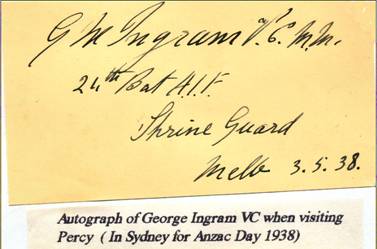
George Ingram received the only Victoria Cross awarded in the 24th Battalion.
***
Viv told me that too many times he had to order young men to go out on patrol. He said it was necessary to appear confident in the mission he was sending them on, when he knew it was likely that some or all of them might not return. He found it almost unbearable to look at their faces and not betray how he was feeling and had to repeat these orders far too often.
***
The phrase ‘Over the Top’ is noted in many books but I understand that some Australians used the words ‘Over the Bag’ or ‘Jumping the Bag’.
***
My mother told me that Viv suffered very badly with hay-fever many times. There are a few entries on his Service Documents of being sent to England to hospital.
***
Viv told my brother David, in response to a question that he never saw any soldiers who drowned in mud. However, he did see some who drowned in water in shell-holes. Many were stuck in mud and had to be hauled out mainly at night, with the help of willing hands and sometimes mules or horses were necessary to get the job done. I believe after reading the book "Passchendaele Unseen Panoramas of the 3rd battle of Ypres" in 2010, it is possible he did not want to tell the truth. As a Company Commander in that area, he would have known about such dreadful deaths, even if he did not actually see them happen.
***
One uncle often talked of his memories to other visiting old soldiers. He was heard having discussions about moving up to the front under crushing shellfire and some men who shot themselves to get out of the line and some dying, as a result because their nerves were so shattered by their experiences.
***
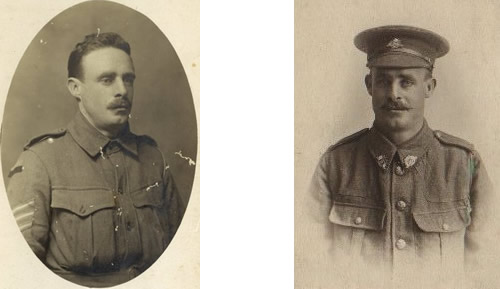
An intriguing tidbit of information came to light when a Facebook contact pointed out that Bert was wearing a British tunic - photo on right.
Pete Pickering sent the following information: “The difference in tunics are the square cut pocket flaps, reinforced shoulders, and metal buttons. This is a British 1902 or 1907 pattern tunic. These were issued when no Australian pattern clothing was available. Trousers also. The Diggers didn't like it at all. It was referred to as "Imperial Pattern" clothing.”
The photo on the left shows Bert in his proper Australian uniform.
***
These entries are NOT stories but two paragraphs from the book shown below, in which Viv is mentioned.
Bullecourt - Arras by Graham Keech (Pages 83-84)
In O.G.1 Gilchrist ran into Lieutenant E. Smythe of the 24th Battalion, who gave him a situation report. Gilchrist went on down the trench where he collected the men of the 6th Brigade and attempted to bomb his way eastwards, but was almost immediately driven back ... (further down the page)
6th Brigade
The 24th battalion closely followed by the 23rd, advanced over ground which lay in the depression and was, therefore, sheltered from the worst of the enemy fire. Those on the extreme right were also able to seek cover under the sunken eastern side of Central Road. When they reached the wire, the barrage had just moved forward, and they entered O.G.1 before the enemy had time to reorganize. Seeing no members of the 5th Brigade, Lieutenant Smythe led a party of the 24th Battalion along about 200 yards to the right before he was stopped by a party of Germans manning a machine gun. The following waves of the two battalions passed over O.G.1, kept close to the creeping barrage and succeeded in taking a stretch of O.G.2 with little resistance. Again, it was clear that no support lay to the right, so Lieutenant R. Pickett followed the example set by Lieutenant Smythe and led a party off in that direction...
NEXT >>







